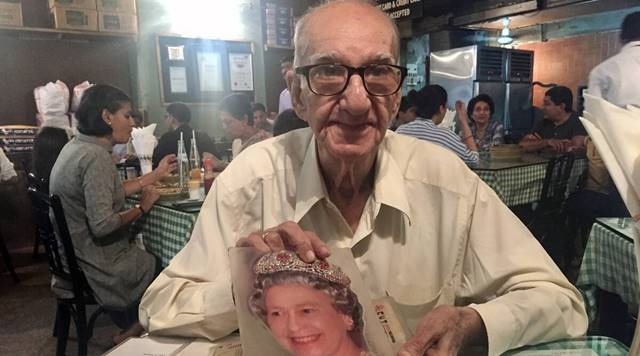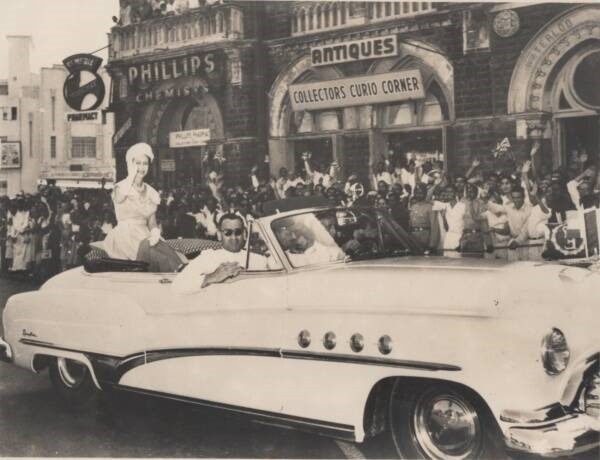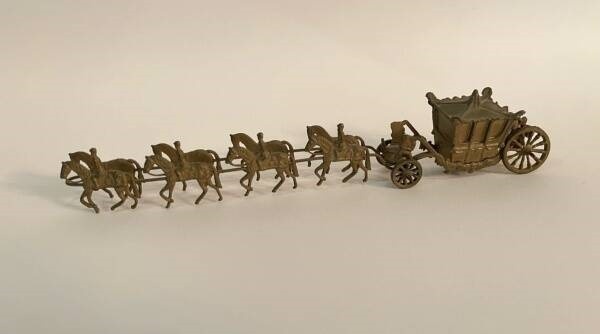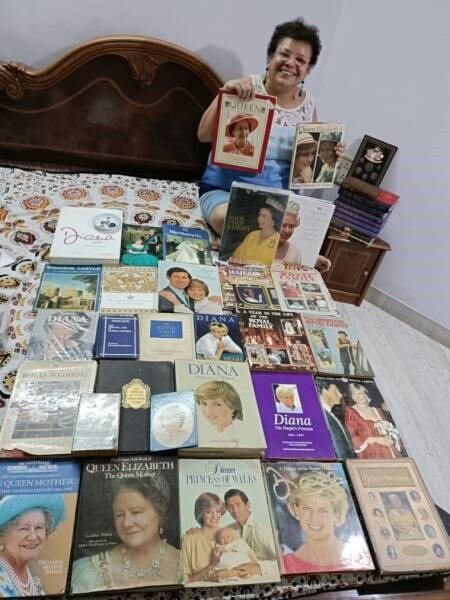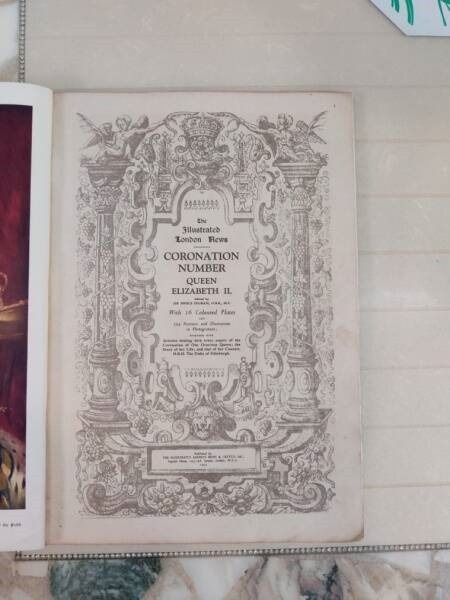This fascination with the British monarchy is not just limited to Bomanbehram, 75. Every Zoroastrian Parsi and Irani home, it is said lightheartedly, has a portrait of the queen, be it Victoria or Elizabeth. The community often referred to Elizabeth as “Aapri Rani” (our queen).
Written by Benita Fernando | Indian Express
The late Boman Rashid Kohinoor, who ran Britannia and Co. cafe, was well known for his fondness for the royal family. Bombaywalla Historical Works
Among Hutokshi Bomanbehram’s family heirlooms is a miniature carriage, all of eight inches, with eight horses and four riders. A closer look reveals it’s a model of the Gold State Coach, the gilded carriage that British monarchs, including Queen Elizabeth II, have ridden in for coronations since 1821. That’s not all — Bomanbehram also owns a 50-year-old Wedgwood plate depicting the Tower of London and coins minted with Elizabeth’s visage.
This fascination with the British monarchy is not just limited to Bomanbehram, 75. Every Zoroastrian Parsi and Irani home, it is said lightheartedly, has a portrait of the queen, be it Victoria or Elizabeth. The community often referred to Elizabeth as “Aapri Rani” (our queen). And when she died on September 8, this refrain rang out across social media posts — some sincere, some tongue-in-cheek.
Bomanbehram, 75, who worked as a secretary at a company, said: “My interest in the British Royal Family is more than I would have for any other royal family. I probably got it from my cousin.”
From the weddings of Charles and Diana and William and Kate to the death of Philip and the Platinum Jubilee—Bomanbehram has caught up with most of the Royal Family’s milestones. The thing she loved the most about the late queen of England — her dignity. “I always got the feeling she was alone. But there was a dignity about her. That’s what I felt drawn towards.”
Press release photograph of Queen Elizabeth II during her royal visit to India in 1961. Passing by Oriental Mansion Building (Opp. NGMA) Courtesy – Phillips Antiques, Mumbai
Noshir Dadrawala, 61, a former trustee of the Bombay Parsi Punchayet, recalls framed portraits of the erstwhile queens at home as a child. The frames are now long gone and the portraits have been tucked away. Dadrawala said: “My parents were from the pre-Independence era, and many continued to cherish a fondness for the British though they accepted the transition [to Independent India]. This didn’t mean they were any less patriotic. Those like Dadabhai Naoroji and Bhikaji Cama were a part of the freedom movement.”
Dadrawala recalled it was common to hear of resemblances between family members and the royals. A generation ago, it was routine to find odd knickknacks and valuable souvenirs connected to the coronation and the jubilees across Parsi and Irani homes. Coins, biscuit tins, tea sets and miniature models were treasured objects.
Sarvar Irani, 61, who works as AGM of administration at a Mumbai mall, has a unique collection, however. Some thirty years ago, Sarvar started seeking out books, souvenirs, carte de visites, postcards and other paper ephemera connected to the British monarchy, especially Elizabeth and Diana. Her favourite is on the coronation of Elizabeth published in 1953 by the Illustrated London News. She has also preserved Time magazine’s commemorative issue on Diana from 1997, the year she died. The souvenir for Elizabeth’s funeral, scheduled for September 19, is next on her list. Sarvar keeps an eye on social media posts and listings in community newspapers for worthwhile acquisitions.
Hutokshi Bomanbehram carriage CREDIT: Mayur Tekchandaney
“I loved the queen for her poise,” she said, observing that even as Elizabeth’s visage aged across portraits and memorabilia, she still had “the same smile and the same twinkle in her eye”.
Sarvar’s daughter Sharon, 37, a writer and researcher, recalls pictures of Charles, Diana and baby William at her aunt’s home back in her childhood. She said: “They were framed photographs so, as a child, I thought they were my relatives. Charles has a Bawa nose, so why not, right?”
Sarvar’s mother migrated from Yazd in Iran to Bombay (as it was then known) before independence. Sharon said migration may be one of the reasons why her community is interested in collecting in general. “Some people may think these royal memorabilia convey an imperialist mindset but a lot of it is about loss. We are keenly aware of time shifting,” she said.
The Zoroastrians arrived in India mainly fleeing persecution in Iran (formerly Persia) since the 7th century AD. They integrated with local communities here, and when the East India Company set up its trading offices in India, they were able to secure jobs as agents. During the Raj, the British accepted Zoroastrians in their offices more easily than other communities, partly owing to their fair skin and their keenness on an English education.
Sarvar Irani
Courtesy: Sharon Irani
“The recent generation has understood this postcolonial hangover. Sometimes we make fun of our grandparents when they share memories of the British,” said actor and singer Zervaan Bunshah. Bunshah, 28, is popular for his comic sketches on social media and Elizabeth’s death elicited a humorous take on his community. In a sketch titled “Aapri Rani” he performs as fictional Zoroastrian characters, each lamenting the death.
“So inspired by her,” cries one, “we named all our baugs colonies… obviously I’m not comparing to her colonies…” Another looks to the heavens and says, “This is the second queen you have taken away from me,” referring to the late singer Freddie Mercury.
Bunshah said: “The joke is about our obsession with the queen. It’s meant as a joke. But, in the current scenario, audiences take it too seriously and think it’s anti-national. I have received abuses for my post along these lines.”
Thankfully, many Zoroastrians are in on the joke. A post that circulated on WhatsApp on the weekend of September 11, which the Government of India declared as a day of mourning for Elizabeth’s death, said every Parsi home must observe a condolence lunch “to commemorate the passing away of our beloved cousin, albeit 378 times removed.” The menu included mutton dhansak, a traditional funeral dish.
The Zoroastrian figure most notable for his fondness of the Royal Family is the late Boman Rashid Kohinoor. Kohinoor ran Ballard Estate’s popular Irani cafe, Britannia and Co., which his father had set up in 1923. Historian Simin Patel, who is researching Mumbai’s Irani cafes for her upcoming book, had met Kohinoor over the years until his death in 2019 at the age of 97. She observed that while Kohinoor was known to dote on the Royal Family, it was one of his many efforts to build rapport with the international patrons at his restaurant. She said, “This image [of his love of the British royals] was really cultivated in the 2000s. He was very bright, had views on several subjects and was up to date. The fascination with the British was quirky, and the laminated photos helped that, but he had 15 countries that he spoke about at ease.”
At Britannia and Co., Kohinoor hung a portrait of Elizabeth right next to one of Gandhi. His son Afshin, 61, who now runs the cafe, said the portrait was sent to his father, along with a letter from Elizabeth, around 2012, the year of the Diamond Jubilee. The portrait will stay in its place till he runs the cafe, but is not sure of its fate after that, especially since younger generations aren’t keen on it. He said: “My father is gone. The queen is gone. This is all history now.”

